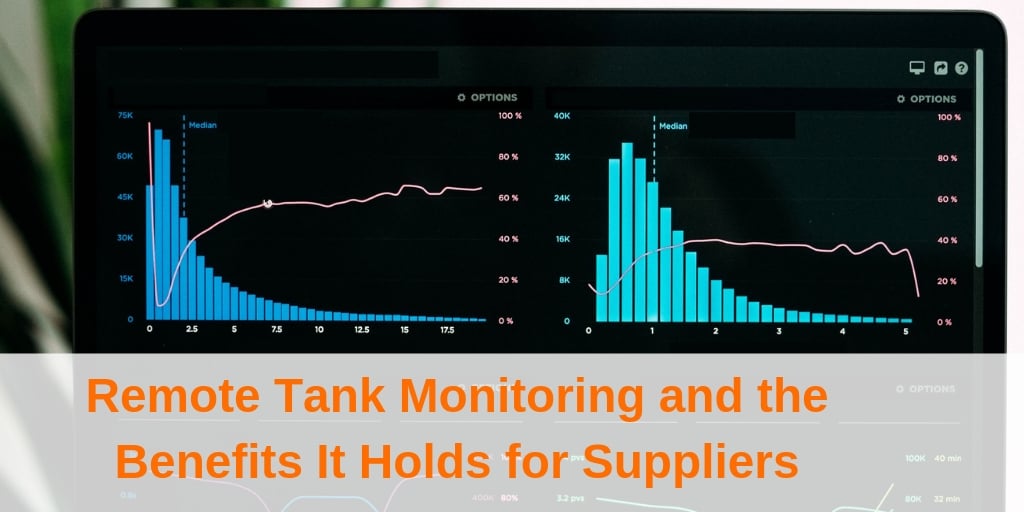
Remote tank monitoring is one of the fastest-growing innovations in the trucking industry. Suppliers are realizing more and more that remote tank monitoring is a must-have addition to their current technology suites rather than a nice-to-have. In fact, a Berg Insight report revealed that in 2017, the number of active remote tank monitoring solutions reached almost 1.8 million units worldwide and 600,000 units in North America.
At its core, remote tank monitoring is a two-part Internet of Things (IoT) solution, functioning with both a hardware and software system. An advanced sensor is installed on or inside a tank, tracking the state of resources inside, such as fill levels. Wireless communication hardware provides real-time updates to a web portal, where suppliers can access a transparent view into their network of tanks and customers can see their individual tank levels.
This multi-layered solution can drastically improve supplier operations, from customer service to business operations — and provide an impressive ROI to boot.
Increased Visibility Into Customer Tank Levels
Suppliers used to rely on educated guesses about customer tank levels for delivery purposes, and some still do. Estimating when tanks need more resources has become an art, and even though these estimates are never exact, they have worked suitably well in the past.
However, with today’s remote tank monitoring, accurate data replaces guesswork. This exchange offers many benefits, like constant visibility into customer fuel levels.
Transparency into customer fuel levels empowers suppliers to know exactly what resources tanks have and need at all times. With employees regularly reviewing remote tank monitoring reports, fuel runouts are no longer a likely problem and neither are unnecessary fuel drops. These smaller benefits snowball, resulting in better customer service, greater fleet efficiency, and more intelligent business decisions.
Better Customer Service
With remote tank monitoring, and the subsequent visibility into customer fuel tank levels it provides, suppliers can easily improve their customer service.
Because tanks are constantly monitored, suppliers receive real-time notifications of low tank levels and are able to plan accordingly. With the data collected, delivery forecasting is also possible, allowing suppliers to more accurately predict usage levels in the future.
All of this real-time and predictive data gives suppliers unparalleled insights into customer usage now and in the future, affording them the opportunity to plan out exactly when they need to service customers. This leads to much happier customers that don’t need to worry about run-outs or contacting their supplier every time they get low. Suppliers are also able to more accurately predict what costs will be like in the future for the customer, lending more transparency and keeping the customer satisfied.
Intelligent Business Decisions
For business leaders, fleet technology has become a vital part of the planning and forecasting process. The data that fleet technology accumulates helps leaders gain big-picture views of their operations that, in turn, empower them to make more informed business decisions. Remote tank monitoring only increases the amount of data that suppliers have access to.
Because remote tank monitoring is scalable, it can be configured to monitor many tanks at once, providing an impressive, overhead view of operations.The longer a business has remote tank monitoring technology, and the more remote tank monitors it has installed, the wider the data sets it collects will be.
Accurate and extensive data sets allow suppliers to conduct wide analyses into customer resource use and devise with new ways to cut costs and streamline operations. Inventory planning and purchasing become data-led activities, empowering suppliers to make more refined decisions based on facts.
Trends are able to be surfaced much easier, leading to business decisions being made on facts rather than educated guesses. This data can become the backbone for organizations to plan for growth in the future and put plans in place now.
Quick ROI
While remote tank monitoring can seem like a large investment, it increases fleet efficiency so much that ROI is fast and plentiful. Efficiencies it creates include:
The elimination of over-servicing. Even if suppliers are adept at estimating when tanks need to be refilled, it is impossible to know exactly how much fuel is in a tank at any given moment without reading an inaccurate gauge in person. Delivering to a somewhat full tank is a common event that wastes driver and delivery resources — but remote tank monitoring eliminates that problem.
Increased drop sizes. Because the amount of gallons delivered per stop increase and the number of unnecessary stops decrease, suppliers can significantly reduce delivery costs with remote tank monitoring.
Just-in-time deliveries. With constant tank monitoring, fixed delivery schedules can become a thing of the past. Drops made on as-needed bases will be the new norm, eliminating wasteful trips.
Reduced delivery expenses. Overservice elimination, increased drop sizes, and just-in-time deliveries will help suppliers reduce the number of trucks and drivers on the road — ultimately reducing delivery labor and vehicle costs while improving service efficiency.
The power to monitor tanks with extreme accuracy is one of the most exciting innovations for suppliers today. The increase in fuel level visibility improves customer service, assists business leaders when they are making critical decisions, and secures a fast ROI. Of all the technologies available to suppliers, remote tank monitoring is becoming a top priority for those looking to streamline their operations.
If you want even more efficiency in your routes, start a conversation with us — we a suite of products and services that can help!

